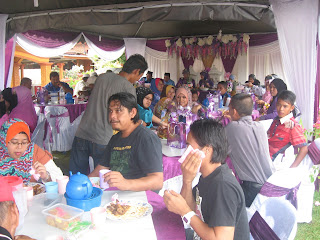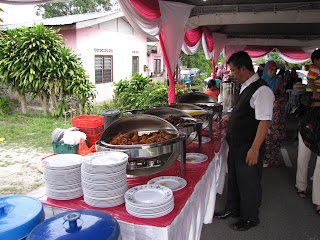The conversation started when I posted a photo album online called “Ramadhan and Raya in Malaysia” in which I included photos of me wearing a hijab, breaking fast with teachers, students, families, and at school, selling and cooking periok kera, playing with fireworks, and chatting with my students on our motorbikes. All very fond memories for me. And all part of my daily life. I often, almost every day, take a step back from my experience and view it from a third person perspective. Without reflection, I go through my day like I’m in the US, taking to friends I’ve always had, engaging in activities I’ve always done, every day learning something new. For me, nothing is different, nothing feels out of place. But then, as I take my step back, I am able to see how much I am blessed, how different my life experiences are from many others’. Here I am, teaching in Malaysia. Every day, I am surrounded by people who desire to learn about me, my country, my language; people who thirst for knowledge though sometimes they are too shy to show it. I am surrounded by people who, despite our clear differences in appearance and background, have brought me into their families as a daughter, a sister, and a role model. Every day, I am surrounded by Muslims, Hindus, Buddhists, Taoists, and Christians; Malays, Indians, and Chinese; boys, girls, women, and men of all ages; Bahasa Malaysia speakers, Tamil speakers, Mandarin or Hokkien speakers, and English as a Second Language speakers; and not ever do I think that one person, for any given reason, is better than another. I am blessed beyond words.

Over the past eight months, I can see how I have grown, how I have learned about myself and the numerous distinct cultures that create the single culture that is Malaysia. How easily I forget that I am different, that my skin is white, that my hair is blonde, that my eyes are blue, that I have a silly accent, or that people constantly question my presence in this small town of Labis. It’s only when I meet new people or wear new cultural clothes, it’s only when other people ask me questions about my background or compliment me on my appearance in Malaysian clothes that I remember: I am indeed different. Not a good or bad different, just different. And I want to be different. After all, that’s who I am. I’m not Malaysian; I’m American. And this fact alone provides a golden opportunity for extensive two-way cultural exchange.
Every day I learn something new about Malaysia and every day I share something new about the United States. Occasionally, I write blogs and post pictures about my experiences so that my friends and family in the United States can also discover something about Malaysia, a place some cannot even find on a map. The pictures and blogs have raised some questions regarding the culture of Malaysia and the Islamic religion that I have been thankful for. For the two-way cultural exchange to be complete, I desire to share my newfound knowledge with my American friends and family.
I am thankful for this dialogue. I am thankful for the discussion that my photos have aroused. I am thankful for the opportunity to teach others about a religion and culture that is often misunderstood. I am thankful for the personal need to try to understand where perceptions, conceptions, and beliefs originate. I am thankful for my open-mindedness. I am blessed.
Here is the conversation regarding my photo album. The names of the individuals have been changed.
Amy I thought the very young girls weren't required to wear the head coverings.........?
Leslie Amy, the very young girls are typically not required to cover. It is often a choice made by the parents of the girls. When the girls reach puberty or enter secondary school, they usually start if they have not already. However, even if they do not cover in public, head scarves are a mandatory part of the primary and secondary school uniforms.
Sarah Mandatory is kind of sad, in my view.
Francis Don't forget, Sarah, you went to a school with a uniform that you had to wear. Same thing, just different.
Sarah And every Friday, we could wear whatever we wanted.
Amy AND, you could go to a different school which did not require a uniform.
Sarah exactly.
Leslie Try to look at it from the Malaysian or Muslim perspectives. I know it's difficult to understand, but this is part of the culture and religion. Malaysia is by definition an Islamic country. The Quran states that the women must cover to protect themselves from sin, avoid tempting the men, and to show respect to Allah. I have met adult Muslim women who don't cover at all. They believe it is not yet their calling. Non-Muslims are not required to wear head scarves and Muslims still do have a choice outside of governmental schools. However, covering their bodies is a symbol of devotion to their God and thus a way of life.
*****
Last weekend, I went to the wedding of a teacher’s younger sister. The bride is 24 years old, and this March, she started wearing the niqaab. Most Malay women wear the tudong which covers the neck and hair. The niqaab goes a step farther and covers the mouth and nose; thus, leaving only the eyes to be seen. I asked the bride about this decision, and she explained to me that she simply felt it was her calling. Covering is a sign of respect toward Allah. The extent of covering cannot truly be forced upon a person; the strength must be found within the person’s being. Asking my fellow teacher about it, she said that even she was surprised when her sister started wearing the niqaab. It made her rethink her pre-conceived notions about the niqaab, knowing well her sister’s social personality and devotion to Allah.


It’s easy to distrust what you cannot see. It’s easy to misunderstand people who and things which are different. It takes strength and desire to uncover the true meaning behind these differences. I have become very used to seeing the tudong; in fact, it is more noticeable to me now when I see a Malay woman’s hair. I admit, however, that I was quite shocked to see the bride wearing a niqaab on the day of her wedding, especially because she was not wearing it when I first met her.
The mother also wears the niqaab in public and has been wearing it for over 20 years. When I arrived at the house though, she wasn’t even wearing a tudong; she had on only an under cap – the hat which is wore under the tudong. So I was also quite surprised when I saw her wearing the niqaab later.
I have given much thought as to why my emotions were so different toward the bride and her mother when I saw them wearing the niqaab. I recognized feelings of confusion and surprise in myself. I questioned why they wear the niqaab; why isn’t the tudong enough for them? Why was I shocked and full of questioning at this added level of covering? After all, I don’t think twice about the tudongs. Perhaps it was good for me to get to know them and their personalities before I saw them fully covered. It helped distill my former perceptions of the niqaab as they were the first niqaab-wearing women with whom I have developed a relationship.
I think for me it has to do with not being able to see expression, of not knowing who is under the niqaab. The eyes alone can be very expressive, but I feel that the full emotion is revealed through the positioning of all of the facial muscles – together they create the whole expressive message. For me, that is all I have ever known. I am not used to only seeing eyes, and thus it was quite difficult for me to understand at first. I am glad I have had this opportunity to further my understanding of head coverings and what they mean to individual women.
I realize where Amy and Sarah are coming from; many Americans are not exposed to Islam and its teachings in the United States. The events of September 11th, 2001 still haunt many people’s thoughts about Muslims and continue to cause individuals to hold misconceptions about the Islam religion as a whole. September 11th greatly affected most, if not all, Americans. Even though the events were 12 years ago, the emotions remain – the misconceptions about Islam and its followers, the belief that most, if not all, Muslims are extremists and hate America. I believe these beliefs stem from a lack of knowledge and a fear of the unknown, or differences. The needed knowledge will not just suddenly appear; it must be sought out and discovered. I strongly believe that efforts, on both large and small scales, must be made to understand this major world religion.

Let’s all take this time to remember that beauty comes in all shapes and sizes. And the most important beauty is internal; it cannot be seen by the naked eye.












































